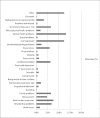Callers' experiences of contacting a national suicide prevention helpline: report of an online survey
- PMID: 22759662
- PMCID: PMC3643796
- DOI: 10.1027/0227-5910/a000151
Callers' experiences of contacting a national suicide prevention helpline: report of an online survey
Abstract
Background: Helplines are a significant phenomenon in the mixed economy of health and social care. Given the often anonymous and fleeting nature of caller contact, it is difficult to obtain data about their impact and how users perceive their value. This paper reports findings from an online survey of callers contacting Samaritans emotional support services.
Aims: To explore the (self-reported) characteristics of callers using a national suicide prevention helpline and their reasons given for contacting the service, and to present the users' evaluations of the service they received.
Methods: Online survey of a self-selected sample of callers.
Results: 1,309 responses were received between May 2008 and May 2009. There were high incidences of expressed suicidality and mental health issues. Regular and ongoing use of the service was common. Respondents used the service for complex and varied reasons and often as part of a network of support.
Conclusions: Respondents reported high levels of satisfaction with the service and perceived contact to be helpful. Although Samaritans aims to provide a crisis service, many callers do not access this in isolation or as a last resort, instead contacting the organization selectively and often in tandem with other types of support.
Figures
References
-
- Barbe R. P., Bridge J., Birmaher B., Kolko D., & Brent D. A. (2004). Suicidality and its relationship to treatment outcomes in depressed adolescents. Suicide and Life-Threatening Behavior, 34, 44–55. doi 10.1521/suli.34.1.44.27768 - PubMed
-
- Bernburg J. G., Thorlindsson T., & Sigfusdottir I. D. (2009). The spreading of suicidal behavior: The contextual effect of community household poverty on adolescent suicidal behavior and the mediating role of suicide suggestion. Social Science and Medicine, 68, 380–389. doi 10.1016/j.socscimed.2008.10.020 - PubMed
-
- Boddy J., Smith M., & Simon A. (2004). Evaluation of Parentline Plus (Home Office Online Report 33/04). Great Britain: Home Office. Retrieved from http://dera.ioe.ac.uk/8438/
-
- Cattan M., Kime N., & Bagnall A.-M. (2009). Low-level support for socially isolated older people: An evaluation of telephone befriending. London, UK: Help the Aged. - PubMed
Publication types
MeSH terms
LinkOut - more resources
Full Text Sources
Medical





